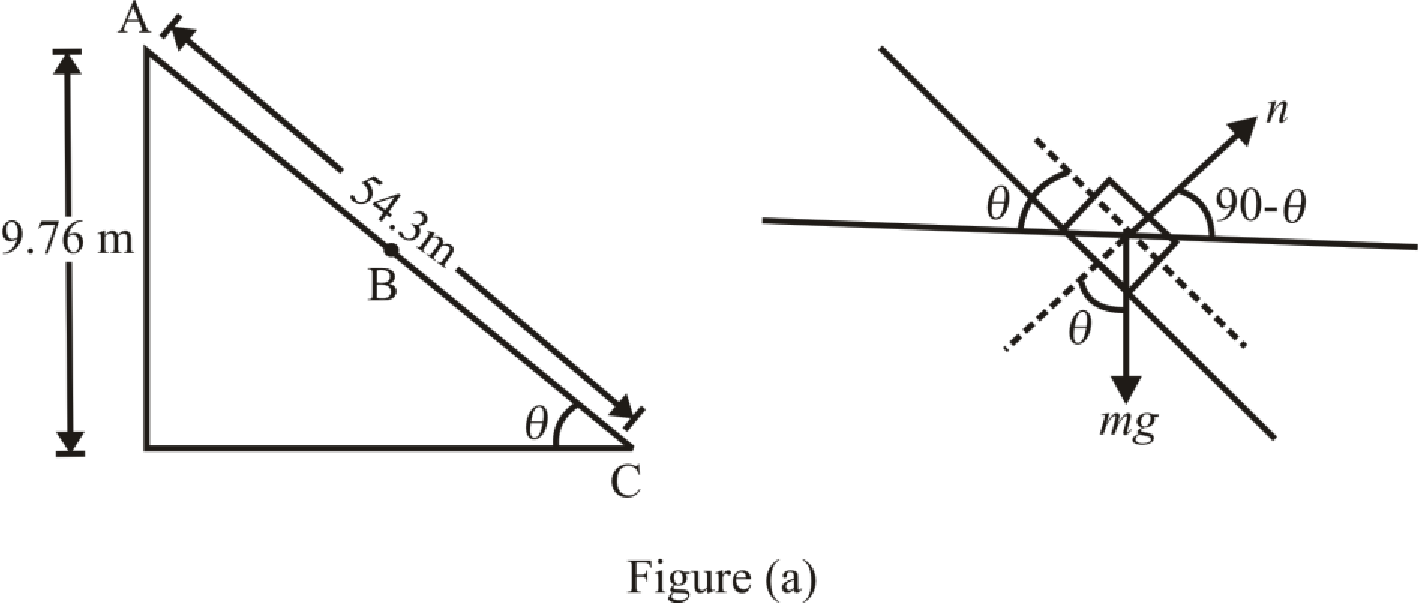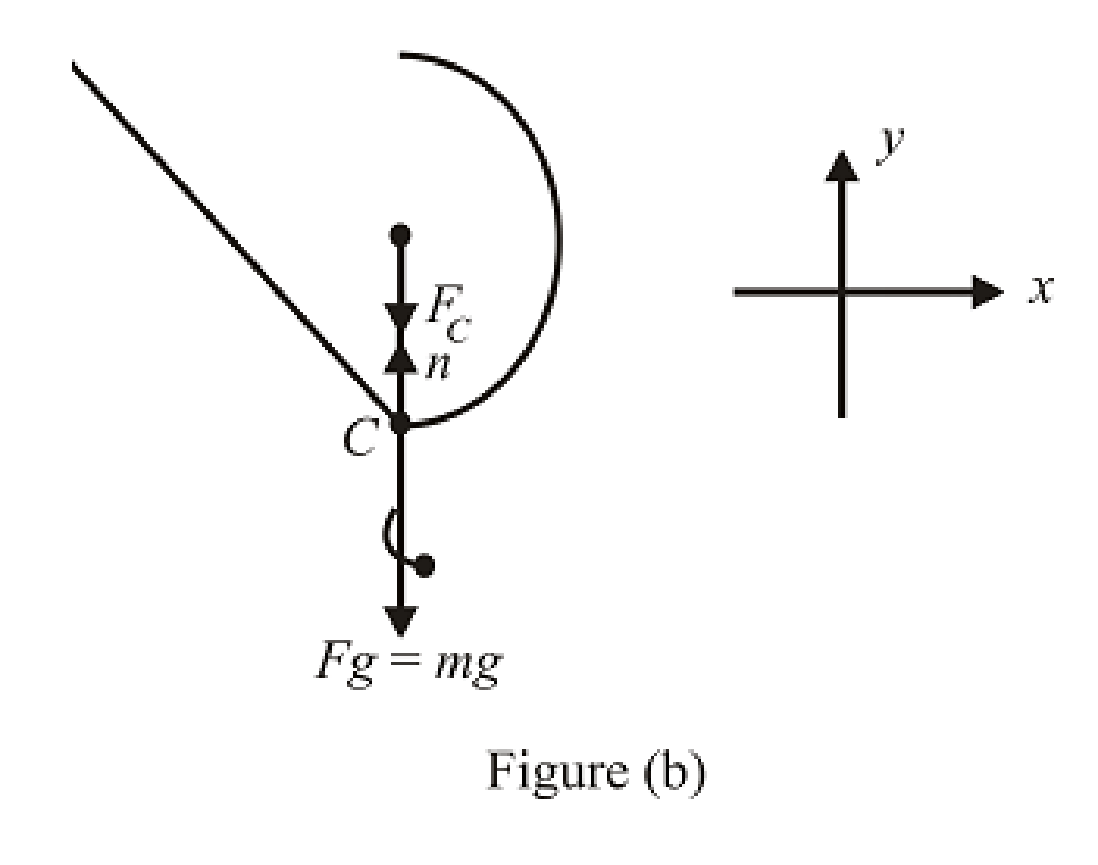
Concept explainers
(a)
The speed of the sled and rider at point C.
(a)
Answer to Problem 77AP
The speed of slader and rider at point C is
Explanation of Solution
Consider sled-chute-earth as an isolated system. Since, there is no friction force acting on the system.
Write the eqution for conservation of energy from point A to point C.
Write the equation for conservation of energy
Here,
Since, the system has potential energy due to gravitation of earth.
Write the equation for gravitational potential energy.
Here,
Write the expression for change in potential energy of the system.
Here,
Substitute
Simplify the above equation.
Here,
Since, the system has kinetic energy due to motion of sled and rider.
Write the equation for kinetic energy.
Here,
Write the expression for the change in kinetic energy.
Here,
Substitute
Simplify the above equation.
Here,
Substitute
Rearrange the above equation for
Conclusion:
Substitute
Thus, the speed of slader and rider at point C is
(b)
The magnitude of the total force the water exerts on the sled.
(b)
Answer to Problem 77AP
The magnitude of the total force the water exerts on the sled is
Explanation of Solution
Consider sled-water as a system.
Since, the friction force exerted by water is in retarding force and hence non-conservative force.
Write the equation for conservation of energy
Here,
Write the equation for work done by retarding force.
Here,
Substitute
Rearrange the above equation for
Simplify the above equation.
Since, the total force exerted by the water is friction force and normal force acting on the sled.
Write the equation for normal force
Here,
Write the expression for the magnitude of the total force
Here,
Since, the normal force and friction force are exerted in perpendicular direction.
Substitute
Simplify the above equation.
Conclusion:
Subsitute
Subsitute
Substitute
Thus, the magnitude of the total force the water exerts on the sled is
(c)
The magnitude of the force the chute exerts on the sled at point B.
(c)
Answer to Problem 77AP
The magnitude of the force the chute exerts on the sled at point B is
Explanation of Solution
Consider the sled on the chute at the point B as shown in figure (a).

Write the expression for the angle
Here,
Since, there is no motion in perpendicular direction fo the motion of sled, hence the net force at the point B will be zero.
Write the expression for net force in y-direction as shown in figure (I).
Here,
Conside the free body diagram of the sled and rider at point B.
Write the expression for net force.
Substitute
Rearrange the above equation for
Conclusion:
Substitute
Substitute
Thus, the magnitude of the force the chute exerts on the sled at point B is
(d)
The force exerted by the chute on the sled at point C where the chute is curving in the vertical plane.
(d)
Answer to Problem 77AP
The force exerted by the chute on the sled at point C where the chute is curving in the vertical plane is
Explanation of Solution
Consider the chute is curving in the vertical plane at point C.

The free body diagram of the sled at point C is as shown in figure (b).
Since, the sled has normal force and the centripital force is outward the center of curve.
Write the equation for net force at point C.
Here,
Substitute
Rearrange the above equation.
Conclusion:
Subsitute
Thus, the force exerted by the chute on the sled at point C where the chute is curving in the vertical plane is
Want to see more full solutions like this?
Chapter 8 Solutions
Bundle: Physics for Scientists and Engineers with Modern Physics, Loose-leaf Version, 9th + WebAssign Printed Access Card, Multi-Term
- Close-up view etermine; The volume of the object given that the initial level of water in the measuring cylinder 23cm3. The density of the object. simple cell made by dipping copper and zinc plates into dilute sulfuric acid solution. A bull onnected across the plates using a wire. State what constitute current flow through the wire The bulb connected across is observed to light for some time and then goes out. State t possible asons for this observation. State two ways in which the processes named in question (b) above can be minimized t the bulb light for a longer period. ead is rated 80Ah. Determine the current that can be drawn continuouslyarrow_forwardAnswers with -1.828, -1.31 or 939.3 are not correct.arrow_forwardThree slits, each separated from its neighbor by d = 0.06 mm, are illuminated by a coherent light source of wavelength 550 nm. The slits are extremely narrow. A screen is located L = 2.5 m from the slits. The intensity on the centerline is 0.05 W. Consider a location on the screen x = 1.72 cm from the centerline. a) Draw the phasors, according to the phasor model for the addition of harmonic waves, appropriate for this location. b) From the phasor diagram, calculate the intensity of light at this location.arrow_forward
- A Jamin interferometer is a device for measuring or for comparing the indices of refraction of gases. A beam of monochromatic light is split into two parts, each of which is directed along the axis of a separate cylindrical tube before being recombined into a single beam that is viewed through a telescope. Suppose we are given the following, • Length of each tube is L = 0.4 m. • λ= 598 nm. Both tubes are initially evacuated, and constructive interference is observed in the center of the field of view. As air is slowly let into one of the tubes, the central field of view changes dark and back to bright a total of 198 times. (a) What is the index of refraction for air? (b) If the fringes can be counted to ±0.25 fringe, where one fringe is equivalent to one complete cycle of intensity variation at the center of the field of view, to what accuracy can the index of refraction of air be determined by this experiment?arrow_forward1. An arrangement of three charges is shown below where q₁ = 1.6 × 10-19 C, q2 = -1.6×10-19 C, and q3 3.2 x 10-19 C. 2 cm Y 93 92 91 X 3 cm (a) Calculate the magnitude and direction of the net force on q₁. (b) Sketch the direction of the forces on qiarrow_forward(Figure 1)In each case let w be the weight of the suspended crate full of priceless art objects. The strut is uniform and also has weight w Find the direction of the force exerted on the strut by the pivot in the arrangement (a). Express your answer in degrees. Find the tension Tb in the cable in the arrangement (b). Express your answer in terms of w. Find the magnitude of the force exerted on the strut by the pivot in the arrangement (b). Express your answer in terms of w.arrow_forward
- (Figure 1)In each case let ww be the weight of the suspended crate full of priceless art objects. The strut is uniform and also has weight w. Find the direction of the force exerted on the strut by the pivot in the arrangement (b). Express your answer in degrees.arrow_forwardA 70.0 cm, uniform, 40.0 N shelf is supported horizontally by two vertical wires attached to the sloping ceiling (Figure 1). A very small 20.0 N tool is placed on the shelf midway between the points where the wires are attached to it. Find the tension in the left-hand wire. Express your answer with the appropriate units.arrow_forwardFind the total bind Mev. binding energy for 13 Carbon, 6C (atomic mass = 13.0033554)arrow_forward
- What is the 27 energy absorbed in this endothermic Auclear reaction 2] Al + 'n → 27 Mg + ! H? (The atom mass of "Al is 26.981539u. and that of 11 Mg is 26.984341u) MeVarrow_forwardWhat is the energy released in this nuclear reaction 1 F + "', H-1 O+ He? 19 19 16 (The atomic mass of 1F is 18.998403 u, and that of 20 is 15.9949154) MeV.arrow_forwardWhat is the energy released in this B+ nuclear reaction خالد 2½ Al w/ Mg + ie? (The atomic mass of 11 Al is 23.9999394 and that > of 12 Mg is 23.985041 u) MeV.arrow_forward
 Principles of Physics: A Calculus-Based TextPhysicsISBN:9781133104261Author:Raymond A. Serway, John W. JewettPublisher:Cengage Learning
Principles of Physics: A Calculus-Based TextPhysicsISBN:9781133104261Author:Raymond A. Serway, John W. JewettPublisher:Cengage Learning Physics for Scientists and Engineers: Foundations...PhysicsISBN:9781133939146Author:Katz, Debora M.Publisher:Cengage Learning
Physics for Scientists and Engineers: Foundations...PhysicsISBN:9781133939146Author:Katz, Debora M.Publisher:Cengage Learning Physics for Scientists and EngineersPhysicsISBN:9781337553278Author:Raymond A. Serway, John W. JewettPublisher:Cengage Learning
Physics for Scientists and EngineersPhysicsISBN:9781337553278Author:Raymond A. Serway, John W. JewettPublisher:Cengage Learning Physics for Scientists and Engineers with Modern ...PhysicsISBN:9781337553292Author:Raymond A. Serway, John W. JewettPublisher:Cengage Learning
Physics for Scientists and Engineers with Modern ...PhysicsISBN:9781337553292Author:Raymond A. Serway, John W. JewettPublisher:Cengage Learning University Physics Volume 1PhysicsISBN:9781938168277Author:William Moebs, Samuel J. Ling, Jeff SannyPublisher:OpenStax - Rice University
University Physics Volume 1PhysicsISBN:9781938168277Author:William Moebs, Samuel J. Ling, Jeff SannyPublisher:OpenStax - Rice University College PhysicsPhysicsISBN:9781285737027Author:Raymond A. Serway, Chris VuillePublisher:Cengage Learning
College PhysicsPhysicsISBN:9781285737027Author:Raymond A. Serway, Chris VuillePublisher:Cengage Learning





